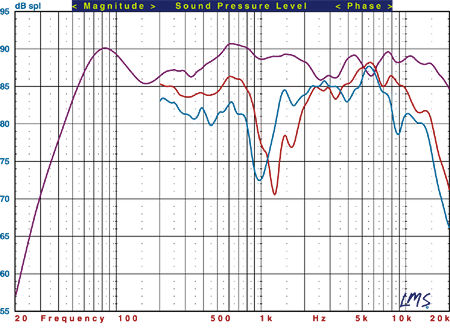PSB Platinum M2 surround speaker system Measurements
The PSB M2's ported enclosure is tuned to approximately 40Hz, with a minimum impedance of 3.23ohms at 172Hz. I would rate the nominal impedance at 6ohms, with a benign phase angle. Any good amplifier comfortable with a 4ohms load should have no trouble driving it. The speaker's sensitivity measured approximately 85dB/W/m.
The horizontal front response of the M2 is shown in Fig.1 (violet). This is the pseudo-anechoic response averaged over a 30° forward horizontal angle (+/-15°), at tweeter height, combined with the nearfield responses of the woofer and port. The effective lower limit of the speaker (–10dB at 35Hz, referenced to the level at 1kHz) is very good for a speaker of this size.

Fig.1: PSB M2, Pseudo-anechoic response off horizontal axis at 45° (red) and 60° (blue).
The averaged front horizontal response of the M2 is extremely smooth across most of the range, with a very flat and extended high-treble region. The measurements (for both the M2 and C4) were made with the grilles removed; with the M2's grille in place (not shown), the response was slightly more uneven in the treble, with marginally less energy in the 3.5–9kHz region. At-
extreme off-axis angles, the high frequencies roll off smoothly, with a slight dip also developing around 1–2kHz—just below the crossover region. This dip is relatively small, suggesting that the woofer has good dispersion at the top of its range.
The vertical response shown in Fig.2 indicates that the M2 should sound best if the listener's ears are positioned as close as possible to the vertical axis of the tweeter, or slightly above. The latter is the opposite of what we normally see, and is likely a result (intentional) of mounting the tweeter below the woofer.

Fig.2: PSB M2, Pseudo-anechoic response at 15° above (red) and 15° below (blue) tweeter.
The PSB C4 center-channel's cabinet is tuned to about 45Hz. Its impedance is at a minimum at 98Hz (2.99ohms). I would rate the nominal impedance (conservatively) at 4ohms. While the C4's impedance is much more complex than that of the M2, it should not be difficult for any good amplifier to drive. The C4's sensitivity measured 88dB/W/m.
The measured front horizontal response of the C4, taken on the tweeter axis and averaged in the same manner as described above for the M2, is shown in Fig.3. The speaker's effective lower limit (–10dB) is approximately 41Hz referenced to the level at 1kHz. The measured frequency response of the C4 is not as smooth as that of the M2, but still within a +/-2.5dB window from about 55Hz–18kHz.

Fig.3: PSB C4, Pseudo-anechoic response off horizontal axis at 45° (red) and 60° (blue).
The off-axis responses in Fig.3 show a significant dip centered around 1–1.3kHz (depending on angle). While not shown, this dip is less significant if the listener stays within +/-30° from the straight-ahead angle. At 30° off-axis, the dip is a maximum of –5dB between 1 and 3.5kHz.
While the C4's design is claimed by PSB to provide good response off-axis, in our tests it does not appear to be as effective as the best 3-way, horizontal designs that place a midrange and tweeter vertically, flanked left and right by the woofers. But the measured aberrations of the C4 were not obvious in the listening tests, which were generally performed less than 30° off- axis.
The vertical off-axis response of the C4 (Fig.4) is smooth, and indicates that modest listening angles above and below the tweeter will have little effect on the speaker's performance.

Fig.4: PSB C4, Pseudo anechoic response off horizontal axis at 45° (red) and 60° (blue).
The results show that the PSB M2 and C4 are both well-designed speakers, though considering the difference in price and size, the M2, though less physically imposing, produced a better set of measurements. While it's likely that the larger and more sensitive C4 will play louder than the M2 under stress, I never reached the limits of the M2's capabilities even at high levels, with a subwoofer handling the speaker-straining, extreme bottom end. This suggests that the C2 might itself be a good, alternative option for the center channel, resulting in a desirable array of three identical speakers across the front. That arrangement, however, may not be favored by the décor police in some installations.—TJN
All figures: Violet curve: Pseudo-anechoic response on tweeter axis, averaged across a 30° horizontal window, combined with nearfield woofer and port responses. All measurements taken at 1m.





























































